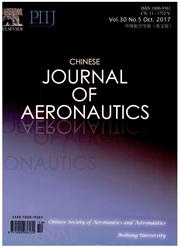

 中文摘要:
中文摘要:
Aimed at evaluating the structural stability and flutter risk of the system, this paper manages to quantify epistemic uncertainty in flutter analysis using evidence theory, including both parametric uncertainty and method selection uncertainty, on the basis of information from limited experimental data of uncertain parameters. Two uncertain variables of the actuator coupling system with unknown probability distributions, that is bending and torsional stiffness, which are both described with multiple intervals and the basic belief assignment(BBA) extricated from the modal test of actuator coupling systems, are taken into account. Considering the difference in dealing with experimental data by different persons and the reliability of various information sources, a new combination rule of evidence––the generalized lower triangular matrices method is formed to acquire the combined BBA. Finally the parametric uncertainty and the epistemic uncertainty of flutter analysis method selection are considered in the same system to realize quantification. A typical rudder of missile is selected to examine the present method, and the dangerous range of velocity as well as relevant belief and plausibility functions is obtained. The results suggest that the present method is effective in obtaining the lower and upper bounds of flutter probability and assessing flutter risk of structures with limited experimental data of uncertain parameters and the belief of different methods.
 英文摘要:
英文摘要:
Aimed at evaluating the structural stability and flutter risk of the system, this paper manages to quantify epistemic uncertainty in flutter analysis using evidence theory, including both parametric uncertainty and method selection uncertainty, on the basis of information from limited experimental data of uncertain parameters. Two uncertain variables of the actuator coupling system with unknown probability distributions, that is bending and torsional stiffness, which are both described with multiple intervals and the basic belief assignment(BBA) extricated from the modal test of actuator coupling systems, are taken into account. Considering the difference in dealing with experimental data by different persons and the reliability of various information sources, a new combination rule of evidence––the generalized lower triangular matrices method is formed to acquire the combined BBA. Finally the parametric uncertainty and the epistemic uncertainty of flutter analysis method selection are considered in the same system to realize quantification. A typical rudder of missile is selected to examine the present method, and the dangerous range of velocity as well as relevant belief and plausibility functions is obtained. The results suggest that the present method is effective in obtaining the lower and upper bounds of flutter probability and assessing flutter risk of structures with limited experimental data of uncertain parameters and the belief of different methods.
 同期刊论文项目
同期刊论文项目
 同项目期刊论文
同项目期刊论文
 Shape sensitivity analysis of flutter characteristics of a low aspect ratio supersonic wing using an
Shape sensitivity analysis of flutter characteristics of a low aspect ratio supersonic wing using an Aeroservoelastic model modification and uncertainty quantification with bayesian posteriori estimati
Aeroservoelastic model modification and uncertainty quantification with bayesian posteriori estimati Aeroelastic two-level optimization for preliminary design of wing structures considering robust cons
Aeroelastic two-level optimization for preliminary design of wing structures considering robust cons 期刊信息
期刊信息
